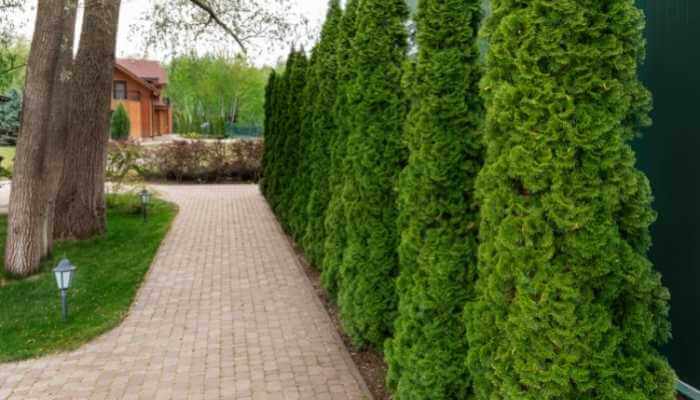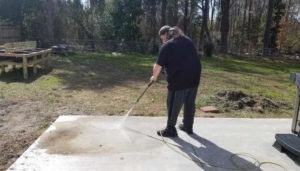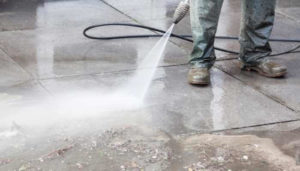We have had our concrete patio poured and cured. The furniture and hot tub are being delivered piece by piece. We’ve decided to go with easy-to-assemble pergolas. I and the hubs walk outside and consider where to put everything when suddenly our peaceful moment is interrupted by the sound of the heat pump cutting on.
We can’t move the heat pump. And we realize the generator is sitting not far away! It’s time to research sound dampening in an outdoor living space!
The five primary methods of sound dampening in an outdoor living space are using plants, installing noise reduction walls, fences, and acoustic materials, visually covering a noise, overwhelming the noise with a sound you like, or landscaping for the purpose of sound dampening.
These are simple ways you can sound dampen around your outdoor living space. If you have any suggestions, let us know!

Plants Can Dampen Sound
Planting evergreen shrubs in your yard will help to absorb sound. And you can plant them as a barrier between the thing making the noise and the patio or whatever you have as your outdoor living space. According to BobVila.com, hedges and thick plants can reduce noise by 10 decibels.
Arborvitae, juniper, hollies, laurel, privet, or other broadleaf evergreens will last all year and grow thick to absorb a lot of sounds. They also tend to have dense foliage to dampen noise better as well. My thought was to make the plants do double duty by planting rosemary and some other perennials that can become bushes tall enough to fill in gaps. These plants not only dampen sound, but bugs do not like them.
Install a Noise-Reducing Wall or Fence
If you have the money for plants as a separation and sound dampening method, you may have money for a wall or fence. This is best for road noise dampening and keeping the sounds from neighboring yards from filtering into your outdoor living space. However, you can also use walls around your backyard noise-nuisances. They even sell sound-proof materials for this.
These barriers can cut outside noise by 5 – 10 decibels in most cases. Make sure your wall is as solid and tall as necessary, and if it is going to be a fence, be sure to abide by your town’s or your HOA’s regulations. That goes for if you plan on upgrading the wall or fence surrounding your outdoor living space with an actual building.
If you have a wall in place or a structure there, and you still need more dampening, or perhaps you need to better accentuate the sound in your outdoor living area over the outside noise, you can always invest in acoustic tiles. There are also sound-dampening mats available.
These materials are not meant to be used alone, they need a wall or place to insulate. They will enhance the sounds inside the space while dampening the sounds outside. They also reduce echo where they are hung. Just be sure to look for the proper way to place them. There are plenty of tutorials out there.
You want the materials between your patio and the incoming sounds to be dense enough to block much of the noise. Materials like hardwoods, brick, stone, and vinyl are good choices. And the thing about walls or plant barricades? They can also help out to reduce noise by tricking your mind.
Visually Covering the Source of the Sound
If you don’t see it, your mind will often ignore it, including whatever noise is being made. Therefore, you’re not only using something to reflect the noise back to the maker and lower the sound, but you’re also getting rid of the visual triggers that make you focus on that sound.
Whether it’s a solid wall made of wood, another material, or plants, if you don’t see the noise’s source, you are less likely to be triggered into focusing on it and getting annoyed by it. This fall, I aim to plant a nice wall of plants to not only dampen the sound of our HVAC unit but keep it out of sight.
If this doesn’t work, you can also trick your mind into ignoring the offensive sound by replacing it with a sound your mind prefers.
Cover Noise with a Sound You Like
My answer to a noise issue at our previous home was to install our own fountain into the already existing pond. The pond was already in the backyard, so we figured, why not? The sound of the water falling down over the stone and into the pond not only provided an extra filtration method for the water in the pond, but it was loud enough that it drowned out all of the neighbors’ sounds.
If you want to build a pond, I have an entire series of articles about that. I would begin with the basic building article and then move on. But, you don’t have to go all-out as we did.
Covering the sounds you dislike with sounds that are more acceptable to your ears can be much simpler. You can always just find or make a water feature that’s small enough to work where you need it to be. Some fans can be aimed not just at you but to push air through leaves. Or, you can use music or even an outdoor white noise machine that helps out.
Landscaping Upward or Downward
One method of dampening noise I learned from a landscape designer takes time and effort but can be very rewarding. You can lower your outdoor living area compared to the area where the source of the unwanted sound is. Dirt is an excellent noise buffer. So you remove dirt to lower the area and place the soil above it between the outdoor living space and the sound source.
Some places have concaved their entire backyard like this to drop noise issues. But I will caution you that this takes time and patience, and you must be sure of your plans. For instance, you should call to be sure digging is safe. Make sure you have all the required permits.
I suggest a landscape designer for help with a project like this because they can usually handle all the moving parts. They will go as far as you want them to – including hiring the appropriate contractors, covering your permits, and overseeing the project. Considering this kind of project includes digging, moving material, and drainage, it may be the best practice.
In Conclusion
If you want to try and limit the noise you hear coming from a source that bothers you while trying to enjoy your outdoor living space, do something about it. I’ve given you several things to consider, and you can do your research and decide which will be best for you. If you have a suggestion I’ve not mentioned here (except moving to an uninhabited island away from the noise), please let me know! In the meantime, you may also want to take a peek at my article about Landscaping for Privacy.











